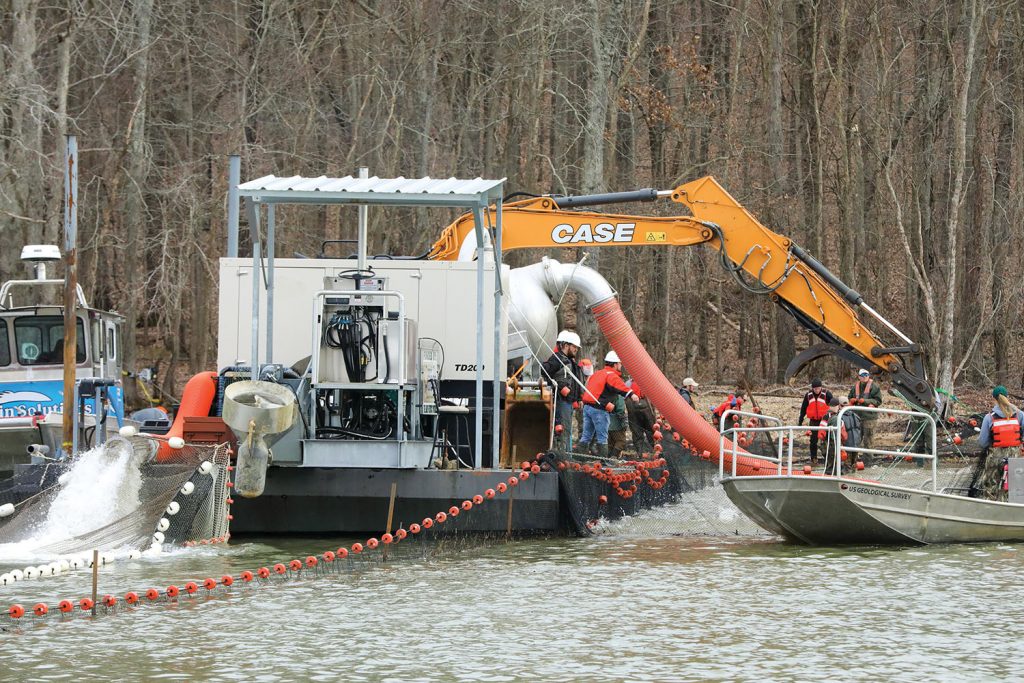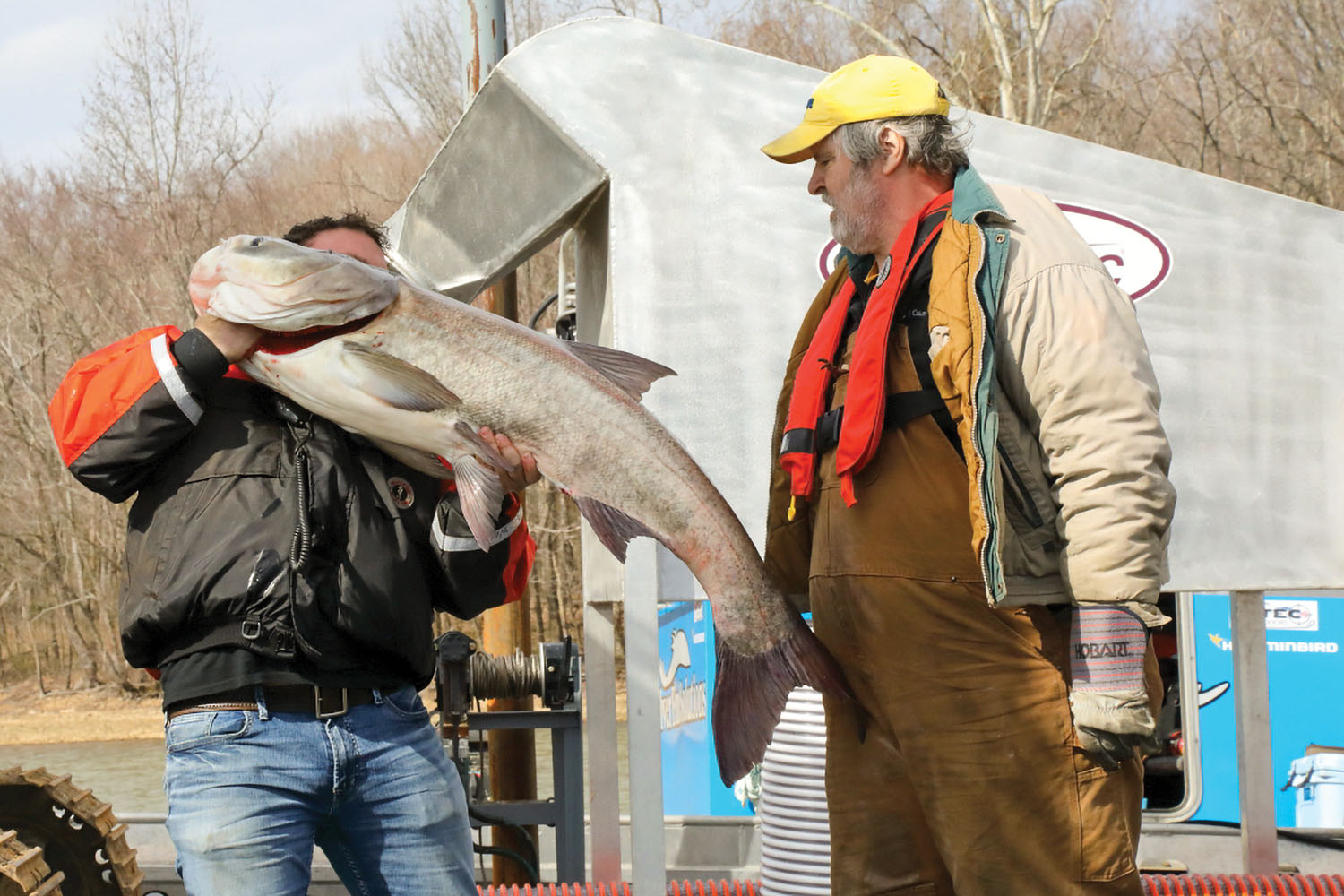An experimental netting and fish pumping method has resulted in the harvest of thousands of pounds of Asian carp in two of Kentucky Lake’s bays this month.
State, federal and local officials began work February 3 in Smith Bay, using what they call the modified unified method. They began by using 2,500 feet of block nets, each reaching 20 to 30 feet deep, to cordon off the mouth of the bay. They then set parallel nets, creating lanes for the invasive fish species. They pushed fish from each lane, eventually forcing the carp into a smaller area, where they were seined, said Ron Brooks, aquatic nuisance species program director for the Kentucky Department of Fish and Wildlife Resources.
Three seine hauls at Smith bay resulted in a harvest of 17,500 pounds of carp, according to the Kentucky Department of Fish and Wildlife Resources.
The netting, along with side-scan sonar, electrical shocking and sound from underwater speakers, are designed to target the invasive Asian carp while allowing native game fish to swim free. The technique was developed by U.S. Geological Survey research fish biologist Duane Chapman, modified from a traditional netting method used in China, where the carp are a popular cuisine.

Organizers also experimented with using a marine fish pump brought in the non-profit group Silver Fin to suck the carp into totes set on a large boat before taking the catch to market for use in making pet foods and fertilizer.
“It’s gone really well, and a big reason for that is everybody wants to be a part of helping out (on) this issue,” Brooks said during the first few days of the project. “It’s such a big issue, it’s so broad, in terms of from Louisiana all the way to Iowa these things are pretty much taking over. There’s a lot of interest in this.”
Later, the Kentucky Department of Fish and Wildlife reported some challenges, including higher-than-expected water temperatures allowing some silver carp to jump out of the nets, as well as some underwater structures brushing up against nets, causing them to ride up and creating brief openings allowing more carp to escape.
“We’re seeing good numbers of fish, and the fish are responding to the speakers and the electro-fishing,” said Kevin Kelly, spokesman for the KDFWR.
After finishing in Smith Bay, organizers made a few adjustments based on what they learned before starting over in Pisgah Bay and felt much better about the results there, Kelly said. No totals were available yet for the second round of harvests, in Pisgah Bay.
“Those involved with the effort learned a tremendous amount over the past 2-1/2 weeks and are encouraged about the method’s potential for future use,” Kelly said.
Neither harvest affected commercial fishing or barge traffic, although nearby small boat ramps closed to the public while they were underway.
Following the mass harvest, organizers planned to use hydroacoustic telemetry to determine the percentage of carp removed from the bays.
“We really want to look at the efficiency,” Brooks said. “The bottom line is we’re trying to get all of the Asian carp out of these lakes that we can, and this kind of system could be very important, another tool.”
He added, “If we can get 80 percent of the fish out of here, that will be something we can work on and move forward with.”
A cost-benefit analysis will also be important, he said.
If the modified unified method works, Brooks envisions annual harvests of carp in the lake in multiple bays each winter will be an additional tool to reduce the population and help restore fishing and boating-based tourism as well as reduce dangers to both commercial and recreational boaters and damage to equipment. The notorious fish are known for frequently jumping into the air, flailing and flopping onto boats and barges with enough impact to injure a mariner or create falling and slipping risks.
“These things are very, very prolific,” Brooks said. “They can out-compete our native sport fish for forage, and they do.”
Kentucky Gov. Andy Beshear, U.S. Senate Majority Leader Mitch McConnell (R-Kentucky) and U.S. Rep. James Comer were among those who made trips to Kentucky Lake to watch the netting and pumping and express their hopes that the experimental method will work well and lead to eradicating Asian carp and restoring tourism in the areas surrounding Kentucky Lake and Lake Barkley.
Asian carp were first introduced to the United States in Arkansas in the 1960s and 1970s for use in controlling algae and other vegetation in aquaculture ponds. By the 1980s, three out of four varieties of the carp had escaped or spread into local bodies of water, according to the U.S. Fish and Wildlife Service. Now the carp are present in the Mississippi, Ohio, Missouri and Illinois rivers and many of their tributaries. Silver carp, the variety of Asian carp most known for jumping, are believed to present in at least 17 states, according to the USFWS.
The modified unified method goes along with another experiment, the Bio-Acoustic Fish Fence (BAFF), which was put in place over the fall at Barkley Dam. The row of bubbles and underwater lights and sounds crossing the downstream lock approach is designed to keep Asian carp from entering Lake Barkley by locking through from the Cumberland River. Lake Barkley, an impoundment of the Cumberland River, and Kentucky Lake, an impoundment of the Tennessee River, are connected by a canal one mile upstream from Barkley Lock and Dam.
Brooks stressed several times that the groups want to work side by side with commercial fishermen, who sometimes remove 10,000 to 15,000 pounds of carp in a single day. Even with the best-case scenario of both the BAFF and the modified unified harvest method working, he said, it will take years to remove carp from Kentucky Lake and Lake Barkley, and commercial fishermen will still have plenty of carp to harvest in the rivers, boosted by state and federal subsidies and free permits and ice distribution.
The modified unified method also helps plan for the future, in determining how best to remove Asian carp from the Great Lakes if they were to migrate that far and to remove them from other lakes where they are already present, Brooks said. That’s one reason he said the U.S. Fish & Wildlife Service was so interested in trying out the experiment at Kentucky Lake. Previously it has been used in portions of Illinois and Missouri, but never in reservoirs that are this deep.
Groups teaming up for the mass carp removal included the U.S. Geological Survey, Kentucky Department of Fish and Wildlife Resources, the U.S. Fish and Wildlife Service, the U.S. Forest Service and the Tennessee Valley Authority as well as fish and wildlife agencies from Tennessee, Alabama, Mississippi and local partners.
Caption for top photo: An Asian carp pulled out of Kentucky Lake. (Photo courtesy of Lee McClellan, Kentucky Department of Fish and Wildlife Resources)




